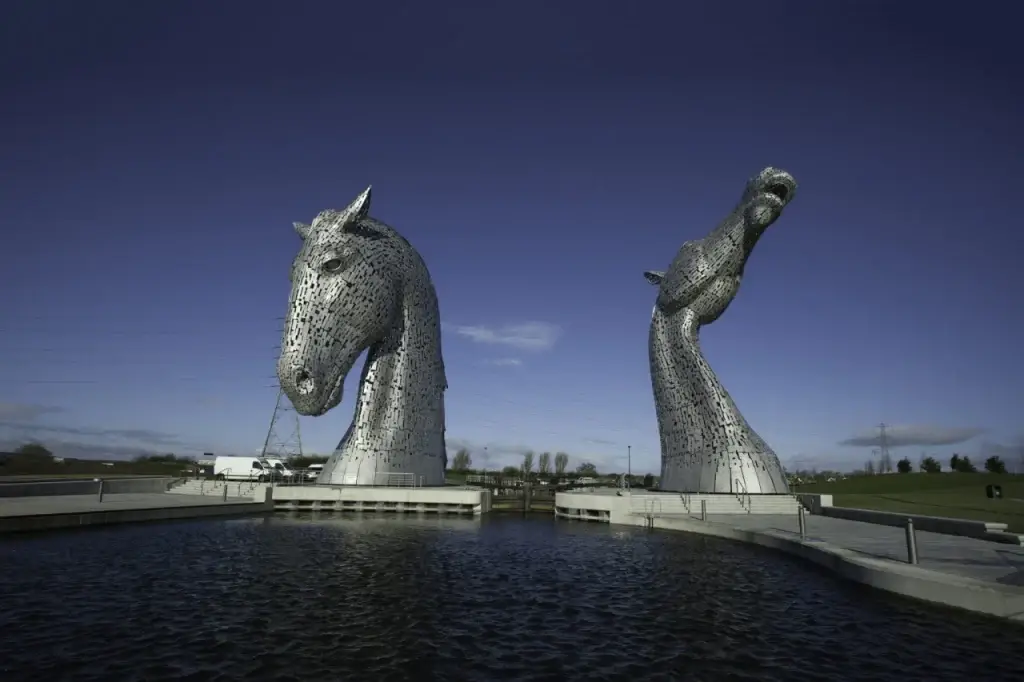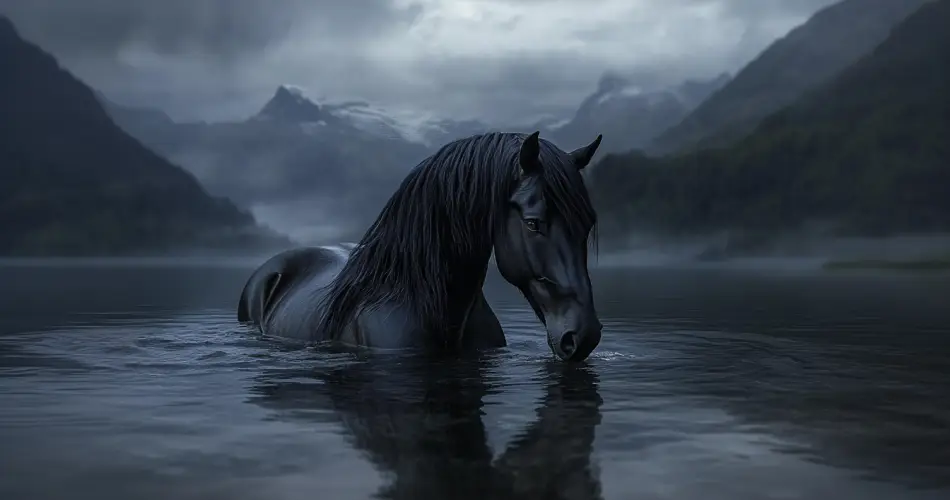Imagine you are walking through a dense Scottish forest. You have been travelling for days and have used up all your supplies. You are exhausted, and your destination is still about three kilometres away.
Suddenly, you see a beautiful black horse grazing peacefully nearby with its bridle and saddle on. You look around, and there is no one else in the area. What a lucky coincidence! Now, you can use the horse to reach your destination in minutes and can also sell the horse for a pretty sum.
As you approach the animal, it kneels and beckons you to sit. Wow! You make yourself comfortable, and you continue your journey.
Suddenly, the horse increases its pace. You try to stop it, but it doesn’t listen. It changes its direction and heads straight for the river you crossed earlier. Now, you are scared and try to get off the animal, but you are stuck to its back. As you struggle, the horse gallops faster and faster.
There is no escape.
You make peace with God as the horse dives into the deep river.
You have just fallen victim to the Kelpie, one of the most scary and vicious creatures in Scottish Mythology. In this post, we’ll tell you everything about this ancient spirit.
What are Kelpies?

Kelpies are dangerous water spirits that have been a part of Scottish and Celtic mythology for centuries. They are shapeshifting creatures that appear as lonely, beautiful black horses beside rivers and other water bodies.
The Kelpie trick unsuspecting victims (usually children and travellers) into climbing their back. It then bolts for the nearest river, where it drowns and devours the unfortunate fellow.
These creatures can also shapeshift into handsome men or beautiful women to attract and trap their victims.
Origin of the Kelpie
The legend of the Kelpie (also called kelpy) is believed to have originated from ancient horse sacrifices performed in Scandinavia and surrounding regions thousands of years ago. However, as Christianity spread to these places, these stories evolved to explain the mysterious drowning of people in the dangerous water bodies of the area.
The Kelpie also served a more practical purpose of keeping children from wandering too close to water. Every river, stream, and lake in Scotland has a kelpie associated with it.
Strangely enough, mythical horse spirits are not uncommon in ancient mythology. In Garmany, there is a similar creature called the Nixe.
Central American and Australian tribes also tell the tale of the Wihwin and the Bunyip.
Read Also: Mysterious Half-seal, Half-human creatures in Celtic Mythology.
Physical Appearance
In their normal form, the Kelpies are said to be one-eyed, horse-like creatures with shapeshifting abilities. However, they often transform into beautiful black or grey horses with a saddle and bridle. They appear like lost horses and invite young men and children to sit on their backs for a ride.
A usual way to identify these kelpie horses is the continuous dripping of water from their mane and the unusual gentleness of the creature.
The creature can also take the form of a handsome young man. In this humanoid form, it can speak human language fluently and can only be identified by hoofs on its feet or seaweed on its hair.
Powers and Characteristics of the Kelpie

The Kelpie waits patiently at the river and tries to lure unsuspecting people to climb its back. As soon as this happens, its skin immediately becomes sticky, and the unfortunate person is unable to dislodge from the horse.
It is relatively safe to ride the Kelpie in inland areas; however, at the slightest scent of water, the creature gallops at an incredible speed to the water and drowns its victims. It then feeds on the victim, leaving only the liver and kidney to float to the surface.
In some other versions of this story, the kepie does not use any trickery to capture its victims. It simply emerges from the water and rushes to its victim with a terrible roar. It snatches the person with its teeth and drags them into the water to devour.
Kelpie Stories in Scottish Mythology
There are several stories featuring the Kelpie in Scottish mythology. Some of these stories are designed to scare children into good behaviour, while others warn young men and women of the danger of courting strangers.
The Kelpie and the children
One of the most famous legends tells of a group of children who found a stunning horse by the water’s edge. Enthralled by its beauty, seven of them climbed onto its back one by one. The eighth child was reluctant to climb on so he resulted to peting the horse.
Soon, the children on the Kelpie become stuck to its sticky skin, and the creature bolted for the deep waters, dragging all but one of the children to their doom.
The lone child, who had touched the creature last, managed to escape by cutting off the part of his hand stuck to the horse.
The Kelpie Transformed
In another story, the Kelpie transforms into a handsome young man and attempts to woo and trap a local woman. However, this attempt was unsuccessful, as the woman could identify the creature through the seaweed in his hair.
She then snatches its necklace, and the Kelpie reverts to its equine form. The creature is then forced to work on a farm for a long time.
Kelpie Weakness

One way to defeat the Kepie is to seize the bridle on its back. Although this is a dangerous manoeuvre, the creature is powerless without its bridle. It is said that the Kelpie, once tamed, can do the work of ten normal horses.
The bridle taken from a kelpie is believed to have magical properties and can be used to transform a person into a horse or cure a disease.
The Kelpie can also be captured using a halter stamped with the cross sign.
How to Kill a Kelpie
Like the werewolf of European mythology, the Kelpie can only be killed with silver bullets. Iron rods might also work; however, this will have to be heated until it is red hot and used to penetrate the creature’s side.
Other Horse Water Spirits in Ancient Mythology
Waterhorse spirits are found in numerous ancient mythologies around the world. Each of these has unique characteristics, but all are associated with the dangers and mystery of water.
Here are a few notable examples.
The Nuggle – Shetland Waterhorse
The legend of the Nuggle (also known as shoopiltee) is found in Shetland Folklore. This creature is a water spirit that takes the shape of a horse like Kelpie. However, Unlike the Kelpie, the Nuggle does not take human form, and it is not inherently evil. It stays around watermills and has a mischievous character.
Also, the Nuggle has a characteristic tail that looks like a wheel. This unique feature makes it easy to recognize, so the creature tries to avoid human contact, only coming out at night.
Wihwin -Miskito Night Hunter
This creature is native to the Miskito tribe of Central America. It is a night hunter that attacks travellers and consumes their flesh.
Unlike the Kelpie, the Wihwin does not employ trickery to catch its prey; instead, it rushes at its victims and tears them apart with its teeth.
Each-Uisge – Demonic Water Horse
The Each-Uisge is another variation of the Kelpie that lives in seas, freshwater, and Sea Loch. Like the Kelpie, this creature can shapeshift, but with the added ability to transform into a bird.
The creatures often wander inland, and it is relatively safe to ride in these areas. However, with the slightest smell of water, its skin becomes adhesive, carrying its rider to the deepest part of the ocean. The creature also feeds on human flesh.
Bunyip -Autrialian Hybrid Monster
The Bunyip is a mythical creature from Australian Aboriginal folklore, believed to inhabit swamps, rivers, and billabongs. Descriptions of the Bunyip vary, but it is often depicted as a large, fearsome beast with features like tusks, flippers, or a dog-like face. The Bunyip was said to devour animals and humans who ventured too close to its domain.
Some believe the Bunyip could be a cultural memory of extinct animals like the Diprotodon, but its origins remain a mystery.
The Symbolism of Water Horse Spirits In Ancient Mythology.
Stories of waterhorse spirits in ancient mythology, such as the Kelpie in Scotland or the Each-Uisge, emerged to explain the mysterious and often deadly nature of bodies of water. In a time when drowning was a common cause of death, these myths explained why people, particularly children, would disappear near water.
Water is a powerful force—both life-giving and deadly. These spirits represent the dangers lurking beneath the surface. The water horse often appeared as a beautiful, enticing creature, luring its victims to their doom.
By weaving fearsome creatures like Kelpies into local folklore, communities created a form of psychological protection, discouraging people from venturing too close to dangerous waters.
In this way, the myths not only explained drownings but also protected individuals from taking unnecessary risks around bodies of water, reinforcing respect for the powerful and unpredictable forces of nature.
Scottish Kelpie Structure in Falkirk

With time, the mythical tale of the Kelpie evolved into a representation of Scottish strength, endurance and cultural identity. This is seen in various Scottish art and literature, video games, music, and films.
The most iconic depiction of the Kelpic in modern times is the 100-ft Kelpie structure commissioned by the Scottish government in 2014.
These massive structures were designed as part of a larger land transformation project to connect 16 communities around Falkirk in Scotland. It also serves as a major tourist centre and attracts more than 500,000 tourists every year.
Who built the Kelpie structure?
The design and construction of the iconic Kelpie structure were done by Andy Scott, a Scottish figurative sculptor. Although the actual construction of the statues started in 2013, the planning and designs started about ten years earlier.
Each sculpture was made from structural steel, with a stainless steel cladding that gives it a shining, silver appearance. The statues were constructed in pieces, which were then assembled on-site.
Standing 30 meters tall and weighing over 300 tons each, they are among the largest equine sculptures in the world. The decision to build them at such a monumental scale was deliberate, as they were intended to command the landscape just like the mythical horses that once dominated the area.
Symbolism of the Kelpic Structure
Beyond their Aesthetic Appeal, the Kelpie structure is also a symbolic tribute to the thousands of horses used in Scotland before the invention of the steam engine.
The mythical Kelpies are believed to be as strong as ten horses; the structures serve as physical embodiment of that strength.
Visiting the Kelpies
The Kelpies are located within The Helix Park, a 350-hectare green space that offers visitors a range of activities and opportunities for exploration.
The park is home to walking and cycling paths, picnic areas, and a visitor centre, which makes it a perfect location for tourists.
While visiting, one of the best ways to appreciate the size and detail of the structure is by walking around their base. There are also several paths that allow visitors to get up close to the sculptures and admire the mastery and creative skill of the creator.
There are also unique vantage points and opportunities for photography. The statues are particularly stunning at sunset when the fading light enhances their reflective surfaces.
Another highlight of visiting the Kelpies is the nighttime light display. After dark, the statues are illuminated with colorful lights that change throughout the evening. This adds an entirely new dimension to the experience, as the Kelpies seem to come alive in the darkness.
